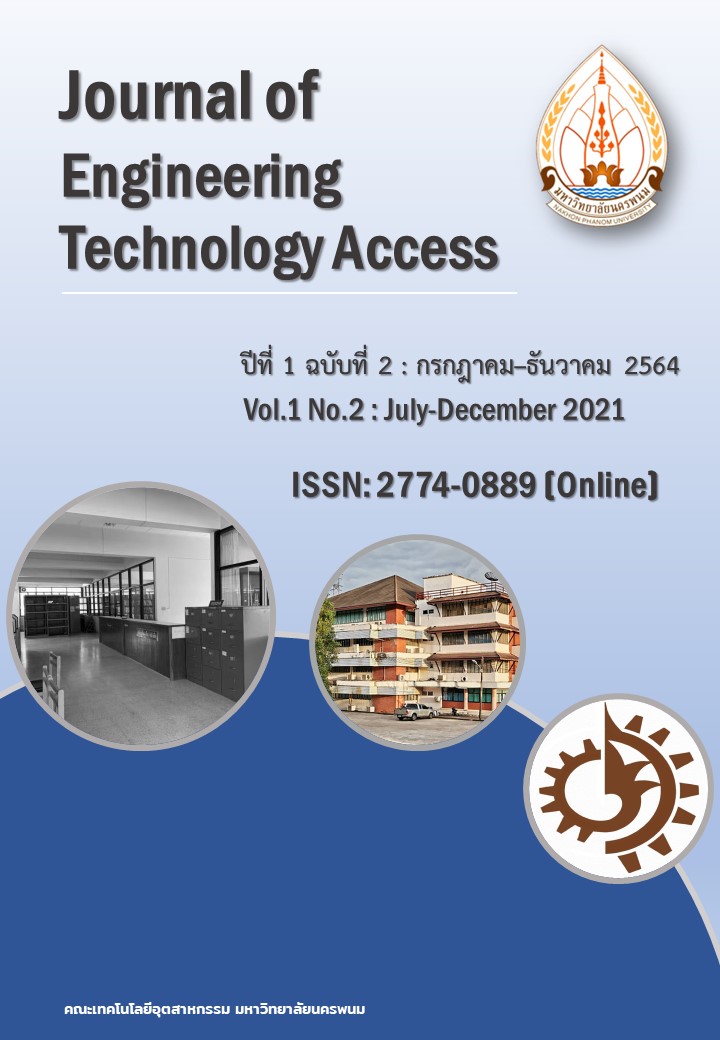The Study Wear Resistant and Microstructural of Welding Zone Brass by Brazing Processes
Main Article Content
Abstract
The objective of this research is to study the wear resistant and microstructure of welding zone brass for brazing processed. To be using to fix the brass nut lock of the water gate valve set of Plumbing systems, Irrigation, and component parts of brass. The experiment was conducted by using Brass material has outside diameter 30 mm. inner diameter 19 mm. to all drilling, and Brazing processed by Brass filler diameter 2.4 and 3.2 mm. and Touch Number 1, 3 and 5, gas flow rate 65, 160 and 350 lt/h., respectively. For Microstructure analysis, Optical Emission Spectroscopy, Hardness and Wear testing. To compare the test specimen that have been brazing to the original brass, and brass nut. The experimental result shows that the optimal process size brass filler were the diameter 2.4 mm. and Touch Number 5 has the hardness 160 HV because gas flow rate is suitable to Brazing process. Microstructure of welding has homogeneity and defect is porosities on the surface weld is less than other experimental variables. But has microstructure similar and consisted of alpha (67 %) + beta phase (20%), place is placed alternately and has black dots spread into round beads within the structure. Because of the specimen have been alloys copper between zinc, and tin (59.91% Cu - 37.85% Zn - 2.02% Pb), respectively. Which be effect to hardness decrease according to the element chemical and has the fretting wear. Because of the friction force to be particles of brass removed and weight loss rate increase follow to time.
Article Details

This work is licensed under a Creative Commons Attribution-NonCommercial-NoDerivatives 4.0 International License.
References
William F. Smith & Javad Hashemi. (2008). Foundations of Materials Science and Engineering (4th ed.). Pp. 346-351.
Copper Development Association Inc. (1994). Copper Casting Alloys, Non-Ferrous Founders’ Society, Des Planes, Llinoise, Pp. 25-52.
Myer Kutz. (2001). Handbook of Materials Selection, Pp. 135-142.
ASM Handbook Volume 18. (1992). Friction, Lubrication, and Wear Technology, Pp. 436-449.
Prasunjai, A., Rojananun, Si. & Rojananun, Su. (2013, February 5-7). Case study of failure analysis on brass Buddha welding [Paper presentation]. Academic Conference 51st Kasetsart University, Bangkok, Thailand.
Meethong, T. & Poopat, B. (2013, October 16-18). Study of Brazing of Dissimilar Metals between Copper Tube and Carbon Steel ASTM A160 Grade B [Paper presentation]. Industrial Engineering Network Academic Conference 2013, Chonburi, Thailand.
Arparjirasakul, D. & Patcharawit, T. and Kitkamthorn, U. (2014, March 29-30). Dry Sliding Wear Characteristics of AISI440C Martensitic Stainless Steel [Paper presentation]. International Conference on Advances in Engineering and Technology (ICAET’2014), Singapore.
Mikell P. Groover, Fundamentals of modern manufacturing: materials, processes and systems (4th ed.). Pp. 507-519.
Rex Miller Mark Richard Miller (2004) Audel Machine Shop Tools and Operations All New (5th Ed.). Pp. 167-193.
Melvin M. Schwartz and Sikorsky Aircraft, (1991) ASM Metals HandBook Vol. 6 - Welding, Brazing, and Soldering, Pp. 270-280.
Mel M. Schwartz, Brazing Second Edition 2003, Pp. 15-21.
American Society for Testing and Materials international ASTM G77, Pp. 310-321.
Sonjaitham, N. and Puangmalee, N. (2014). Wear of UHMWPE based micro composites filled with hard and soft particles under dry sliding, IE network conference 2014, Thailand.
ASM Handbook Volume 2. (1996). Properties and Selection: Nonferrous Alloys and Special -Purpose Materials, ASM International, The Materials Information Society, USA, P. 764.






